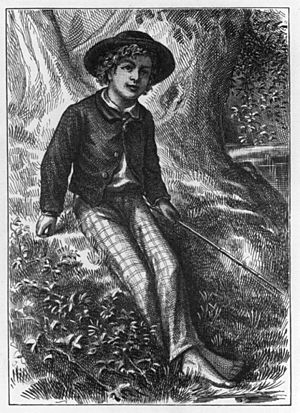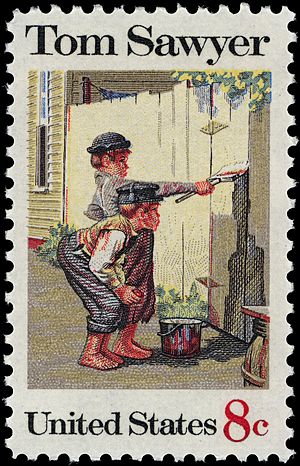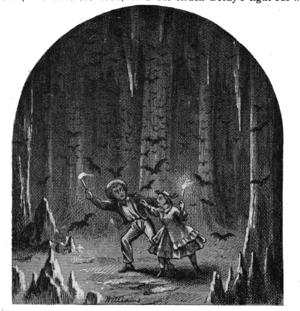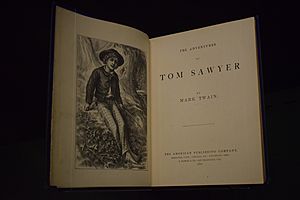The Adventures of Tom Sawyer facts for kids

Front piece of The Adventures of Tom Sawyer, 1876, 1st edition
|
|
| Author | Mark Twain |
|---|---|
| Country | United States |
| Language | English |
| Genre | Bildungsroman, picaresque novel, satire, folk, children's literature |
| Publisher | American Publishing Company |
|
Publication date
|
1876 |
| OCLC | 47052486 |
| 813.4 | |
| LC Class | PZ7.T88 Ad 2001 |
| Followed by | Adventures of Huckleberry Finn |
| Text | The Adventures of Tom Sawyer at Wikisource |
The Adventures of Tom Sawyer (also known simply as Tom Sawyer) is a famous novel written by Mark Twain in 1876. It tells the story of a young boy growing up near the Mississippi River. The story takes place in the 1840s in a town called St. Petersburg. This town is based on Hannibal, Missouri, where Mark Twain lived when he was a boy. In the book, Tom Sawyer goes on many exciting adventures, often with his best friend, Huckleberry Finn. Even though the book wasn't a huge hit at first, it became the best-selling of Twain's books during his lifetime.
Many people think The Adventures of Tom Sawyer is a classic of American literature. It was also one of the first novels ever written using a typewriter.
Contents
The Story of Tom Sawyer


Tom Sawyer is a boy who doesn't have parents. He lives with his Aunt Polly and his half-brother Sid in St. Petersburg, Missouri. This is around the 1840s. Tom loves to have fun and often skips school to play or go swimming. One Friday evening, Aunt Polly catches him sneaking home late. She finds out he was in a fight. As a punishment, she makes him whitewash her fence the next day.
Tom is very clever. He tricks other kids in the neighborhood into doing his boring work. He makes them think that painting the fence is a special "privilege." He uses reverse psychology to convince them it's fun. Later, Tom trades the small trinkets and treasures he got from the kids. He trades them with students in his Sunday school class for tickets. These tickets were given for memorizing verses from the Bible. Tom collects enough tickets to win a valuable Bible from the teacher. This makes the other students jealous. The adults are surprised and proud, even though Tom is not good at remembering Bible verses.
Tom falls in love with Becky Thatcher. She is a new girl in town and the daughter of an important judge. Tom impresses Judge Thatcher at church by winning the Bible. But he shows he doesn't know much about the Bible when he can't answer simple questions. Tom tries to win Becky over. He even gets her to agree to be "engaged" by kissing her. Their romance quickly ends when Becky finds out Tom was "engaged" to another girl, Amy Lawrence.
Soon after Becky rejects Tom, he goes with Huckleberry Finn to a graveyard at midnight. Huck is a boy who wanders around and is admired by the other boys. They go to the graveyard to do a superstitious ritual to cure warts. At the graveyard, they see three men: Dr. Robinson, Muff Potter, and Injun Joe. These men are digging up a grave. A fight starts, and Robinson knocks Potter out. Then, Injun Joe kills Dr. Robinson. When Potter wakes up, Injun Joe puts the weapon in his hand. He tells Potter that he killed Robinson while he was confused. Tom and Huck make a secret promise not to tell anyone about the killing. They are afraid Injun Joe will find out and hurt them. Potter is arrested and put in jail to wait for his court case. He doesn't argue against Injun Joe's story.
Tom gets tired of school. He, his friend Joe Harper, and Huck run away to Jackson's Island in the Mississippi River. They decide to become "pirates." While they are enjoying their freedom, they realize people in their town are searching the river for them. Everyone thinks the boys are missing and have died. Tom secretly goes back home one night to see what is happening. After feeling a little sad about his loved ones' sadness, he comes up with a plan. He decides to show up at his own funeral. The three boys carry out this plan. They make a dramatic entrance at church right in the middle of their funeral service. This stunt earns them huge respect from their classmates. Back at school, Becky accidentally tears a page in the school master's book. Tom startles her, but he wins her admiration back. He takes the blame for the damage and accepts the punishment that would have been hers.
During Potter's court case, Tom breaks his promise with Huck. He tells the court what he saw, saying that Injun Joe was the real killer. Injun Joe runs away from the courtroom before he can be caught. Potter is found innocent. But Tom and Huck now live in fear that Injun Joe will try to get revenge.
When school lets out for the summer, Tom and Huck decide to look for buried treasure. They search an old, empty house. Two men arrive and interrupt them. One of them is a Spanish man who seems unable to speak or hear. The boys recognize him as Injun Joe in disguise. He and his partner plan to bury some stolen treasure in the house. But by accident, they find a large amount of gold coins already hidden there. They decide to move it to a new secret spot. Tom and Huck are determined to find it. One night, Huck follows the men. He overhears them planning to break into the home of the rich Widow Douglas. Injun Joe wants revenge on her because her late husband, a judge, had him punished in public for wandering around without a home. Huck gets help and stops the break-in. But he asks that his name not be told publicly. He is still afraid of Injun Joe.
Just before Huck stops the crime, Tom goes on a picnic to a local cave with Becky and their classmates. Tom and Becky get lost inside the cave for several days. They face starvation and dehydration. Becky becomes very weak and thirsty. Tom desperately searches for a way out. He accidentally sees Injun Joe but is not seen himself. He eventually finds an exit. He and Becky are happily welcomed back to town. They learn they were missing for three days and had traveled five miles from the entrance. Judge Thatcher has the cave's entrance door made stronger and locked. Two weeks later, Tom hears about this. He is horrified, knowing Injun Joe is still inside. He leads a group to the cave. They find Injun Joe dead from starvation just inside the entrance.
A week later, Tom realizes the stolen gold must be hidden in the cave because Injun Joe was there. He takes Huck to the cave to find it. They discover the gold, which is worth over $12,000 (a lot of money in the 1840s!). The money is invested for them. The Widow Douglas adopts Huck. But Huck finds living in a civilized home difficult. He tries to go back to his old life of wandering. He reluctantly returns to the widow. Tom convinces him by offering to form a high-class robber gang.
Why This Book Is Important
This novel has parts that are funny, critical of society, and use satire. These features later made Mark Twain one of the most important writers in American literature. Mark Twain included some real events from his own life in the book. The town of St. Petersburg is based on Twain's actual childhood home of Hannibal. Many places in the book are real and are now tourist attractions.
The book explores what it means to be a boy. It shows Tom's adventures, like running away with Joe and Huckleberry. Tom and Joe even try smoking a pipe to show off to other boys. This helps show how mischievous and adventurous boyhood could be.
How the Book Was Created
Tom Sawyer was Mark Twain's first try at writing a novel by himself. Before this, he had written true stories about his travels, like The Innocents Abroad. He also wrote two short, funny stories that made fun of children's books of that time. These were The Story of the Good Boy and The Story of the Wicked Little Boy. In the first story, a good child is never rewarded and dies before saying his last words. In the second, a bad boy who steals and lies, like Tom Sawyer, ends up rich and successful. Tom is a mix of these boys. He is a bit of a scamp but also kind.
By the time he wrote Tom Sawyer, Twain was already a successful author. He had a big house in Hartford, Connecticut. He needed another successful book to support his wife and two daughters. He had also worked with Charles Dudley Warner on a novel called The Gilded Age, published in 1874.
Twain had written down memories of his own life on the Mississippi River. He also wrote letters to a childhood friend, Will Bowen. Both of these brought back many memories and helped him write the book. Twain named his main character after a real fireman in San Francisco. He met this fireman in 1863. The real Tom Sawyer was a local hero. He was famous for saving 90 passengers after a shipwreck. Twain and the fireman remained friends during Twain's three years in San Francisco.
Publishing the Book
In November 1875, Twain gave his handwritten story to Elisha Bliss of the American Publishing Company. Bliss sent it to True Williams for pictures. Soon after, Twain also had the book published quickly in London by Chatto and Windus in June 1876. This version did not have pictures. Copies that were not authorized quickly appeared in Canada and Germany. The American Publishing Company finally released its version in December 1876. This was the first version of Tom Sawyer with illustrations.
These two early versions are a little different. After finishing his story, Twain had a copy made. His friend William Dean Howells read and wrote notes on this copy. Howells and Twain wrote letters to each other. They talked about the words Twain used, how the characters developed, and other parts of the story. Twain then made changes based on Howells' comments. He put these changes into his original story. But some changes were missed. The English version was based on the corrected copy. The American version with pictures was based on the original story. To make it even more complicated, Twain personally checked the final drafts of the American version. He did not do this for the English version. Because of this, the American version is seen as the most accurate.
Other Stories with Tom Sawyer
Tom Sawyer, the main character, also appears in other books:
- Adventures of Huckleberry Finn (1884)
- Tom Sawyer Abroad (1894)
- Tom Sawyer, Detective (1896)
He is also a character in two unfinished stories by Twain: Huck and Tom Among the Indians and Tom Sawyer's Conspiracy. Tom also appears in Twain's unfinished story Schoolhouse Hill.
Movies, Shows, and More
The Adventures of Tom Sawyer has been made into many movies, TV shows, and other forms of entertainment.
Film and Television
- Tom Sawyer (1917), a silent film starring Jack Pickford.
- Tom Sawyer (1930), starring Jackie Coogan.
- Tom Sawyer (1936), a version from the Soviet Union.
- The Adventures of Tom Sawyer (1938), a colorful film by the Selznick Studio, starring Tommy Kelly. The cave scene was designed by William Cameron Menzies.
- Tom Sawyer (1956), a musical TV episode.
- The Adventures of Tom Sawyer (1960), a BBC television series.
- Les aventures de Tom Sawyer (1968), a TV miniseries from Romania, France, and West Germany.
- Aventurile lui Tom Sawyer (1968), a Romanian movie.
- The New Adventures of Huckleberry Finn (1968), a TV series mixing live-action and animation.
- Las Aventuras de Juliancito (1969), a Mexican film.
- Tom Sawyer (1973), a musical movie with songs by Robert B. Sherman and Richard M. Sherman. It stars Johnny Whitaker as Tom and Jodie Foster as Becky Thatcher.
- Mark Twain's Tom Sawyer (1973), a TV movie.
- Páni kluci (1976), a Czech movie.
- Huckleberry Finn and His Friends (1979), a TV series.
- The Adventures of Tom Sawyer (1980), a Japanese anime TV series.
- The Adventures of Tom Sawyer and Huckleberry Finn (1981), a Soviet Union TV version.
- Rascals and Robbers: The Secret Adventures of Tom Sawyer and Huckleberry Finn (1982), a TV movie.
- Sawyer and Finn (1983), an American TV series pilot.
- Tom Sawyer (1984), a Canadian claymation version.
- Wishbone (1995), an episode where the dog, Wishbone, imagines himself as Tom Sawyer.
- Tom and Huck (1995), starring Jonathan Taylor Thomas as Tom.
- The Animated Adventures of Tom Sawyer (1998), a Canadian animated movie.
- Tom Sawyer (2000), an animated movie where the characters are animals.
- Thomas Sawyer appears as a young adult in the movie League of Extraordinary Gentlemen (2003). He is a U.S. Secret Service agent.
- Tom Sawyer (2011), a German version.
- Tom Sawyer & Huckleberry Finn (2014), starring Joel Courtney as Tom.
- Band of Robbers (2015), a crime comedy film.
Music
- "Tom Sawyer" is a famous song by the Canadian rock band Rush. It was released in 1981 on their album Moving Pictures.
Theatrical Shows
- From 1932 to 1933, German philosopher Theodor Adorno started to adapt The Adventures of Tom Sawyer into a musical play.
- In 1956, a musical called We're From Missouri was created based on the book.
- In 1960, Tom Boyd's musical version (now called Tom Sawyer) was shown in London, England.
- In 1981, a play called The Boys in Autumn showed Tom Sawyer and Huck Finn meeting again as old men.
- In the 1985 musical Big River, Tom is a supporting character.
- In 2001, a musical called The Adventures of Tom Sawyer opened on Broadway.
- In 2015, a 17-year-old writer created a modern play based on The Adventures of Tom Sawyer.
Ballet
Tom Sawyer: A Ballet in Three Acts was first performed on October 14, 2011. It was shown at the Kauffman Center for the Performing Arts in Kansas City, Missouri. The music was by Maury Yeston, and the dances were by William Whitener. This was likely the first all-new, completely American three-act ballet.
Comic Books
The Adventures of Tom Sawyer has been turned into comic books many times:
- Tom Sawyer and Huck Finn (1925)
- Classics Illustrated #50: "The Adventures of Tom Sawyer" (1948)
- Dell Junior Treasury #10: "The Adventures of Tom Sawyer" (1957)
- Joyas Literarias Juveniles #60: "Tom Sawyer detective" (1972)
- Tom Sawyer (1973)
- Joyas Literarias Juveniles #182: "Las aventuras de Tom Sawyer" (1977)
- Classics Illustrated #9: The Adventures of Tom Sawyer (1990)
- Tom Sawyer (An All-Action Classic #2) (2008)
- Classics Illustrated Deluxe #4: The Adventures of Tom Sawyer (2009)
- The Adventures of Tom Sawyer (2007)
- Manga Classics: The Adventures of Tom Sawyer (2018)
Video Games
- The Adventures of Tom Sawyer, an action-platformer game for the Nintendo Entertainment System. It came out in 1989.
- Square's Tom Sawyer, a role-playing video game made by Square. It was released in Japan in 1989.
Internet
On November 30, 2011, Google Doodle celebrated Mark Twain's 176th birthday. The Google Doodle showed a scene from The Adventures of Tom Sawyer.
Theme Park Attractions
An attraction at Six Flags Over Mid America (now Six Flags St Louis) was called Injun Joe's Cave. It told the story of Tom Sawyer and Becky Thatcher escaping from Injun Joe. This attraction was open until 1978.
See also
 In Spanish: Las aventuras de Tom Sawyer para niños
In Spanish: Las aventuras de Tom Sawyer para niños
- Adventures of Huckleberry Finn
- List of Tom Sawyer characters
- Mark Twain bibliography
- National Tom Sawyer Days
- The Story of a Bad Boy


